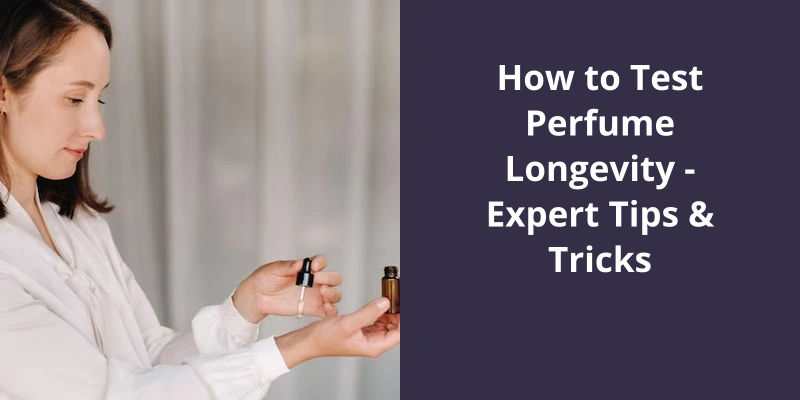Testing perfume longevity is a meticulous process that experts recommend, to gauge the true staying power of your scent. Start by applying the perfume to your pulse points, namely your wrists or neck where your skin is the warmest. This allows the perfume to mix with your body’s natural oils and pheromones, helping to determine how the perfume interacts with your body chemistry. Avoid rubbing your wrists together as it can crush the scent molecules affecting the perfume’s development on your skin. Make sure not to wear other scents – including scented lotion – as they could interfere with your test. To properly evaluate how long the perfume lasts, you need to give it time. Check in on the scent every few hours to notice the changes as it wears. This test provides insights into the evolution of the scent and its total longevity. Finally, remember that diet, skin type, room temperature, and humidity can all influence perfume longevity.

How Do I Know if My Perfume Is Lasting?
You can gauge the longevity of your perfume by simply observing it’s scent throughout the day. If you notice that the fragrance fades away quickly and loses it’s potency within just a few hours, it may be an indication that the perfume isn’t long-lasting. This is particularly true for perfumes that contain vegetable oils, as these oils tend to expire over time, leading to a weaker and less long-lasting scent.
However, perfumes that don’t contain any fat, such as those made with essential oils, are often known for their longevity. This is because essential oils are volatile compounds that evaporate at a slower rate, ensuring that the scent lingers on the skin for a longer period of time.
Certain areas, such as the wrists and neck, tend to have more heat and better blood circulation, which can help the fragrance to last longer. On the other hand, applying perfume on drier parts of the body, like the back of the hand or the back of the ear, may make the scent dissipate more quickly.
Additionally, the concentration of the perfume can also affect it’s longevity. Perfumes with a higher concentration of fragrance oils, such as parfum or extrait de parfum, usually last longer compared to those with lower concentrations like eau de parfum or eau de toilette. So, if youre looking for a long-lasting scent, opt for perfumes with higher concentrations of fragrance oils.
Perfumes with base notes like sandalwood or vanilla tend to have better longevity compared to those with predominantly top notes like citrus or floral scents. Base notes are known for their longer-lasting properties and can help your perfume retain it’s scent for a longer period of time.
This will allow you to make informed choices when selecting perfumes and ensure that you enjoy a long-lasting fragrance experience.
The lingering scent that fills the air will give you a clear indication of the fragrance’s sillage, or it’s ability to project and leave a trail in it’s wake. This simple test allows you to gauge the strength and staying power of your fragrance, helping you determine it’s sillage potential.
How Do You Test Fragrance Sillage?
Fragrance sillage is essentially the measure of how far and how long a perfume scent lingers in the air after it’s been applied. Testing the sillage of a fragrance can give you insight into it’s longevity and overall performance. If youre curious about how to test the sillage of your favorite perfume, there are a few expert tips and tricks you can try.
One simple and effective method is to spray the fragrance just once in a clean, empty room. Make sure to close the door and the windows to contain the scent. After ten to fifteen minutes, open the door and take a deep inhale. This will give you a clear indication of how far and how strongly the fragrance has spread in the confined space.
Another technique you can employ is to apply the perfume on a pulse point, such as your wrist or neck, and then simply go about your daily activities. Pay close attention to how long you can smell the fragrance on yourself throughout the day. This will give you a sense of the perfumes longevity and sillage.
Apply a small amount to your skin and then walk around for a while. This way, you can get a firsthand experience of the perfumes sillage without committing to a full bottle.
It’s worth noting that factors such as temperature, humidity, and the composition of your skin can affect the sillage of a fragrance. Warmer temperatures can amplify the sillage, while cooler temperatures may dampen it. Additionally, dry skin tends to have less sillage, while oily skin can enhance the fragrances projection.
Factors That Affect Fragrance Sillage: Explore in More Detail How Temperature, Humidity, and Skin Composition (Dry vs Oily) Can Impact the Sillage of a Fragrance.
When testing the longevity of a perfume, it’s important to consider several factors that can affect it’s sillage. Temperature, humidity, and skin composition can all have an impact on how long a fragrance lasts on the skin and how far the scent travels.
Temperature plays a crucial role in how a perfume develops and projects. Higher temperatures can cause the volatile molecules in a fragrance to evaporate more quickly, which may lead to a shorter scent life and weaker sillage. On the other hand, colder temperatures can slow down the evaporation process, allowing the fragrance to last longer and have a stronger sillage.
Humidity levels can also influence the longevity and sillage of a perfume. In humid environments, the moisture in the air can interact with the fragrance molecules, altering their composition and reducing their staying power. This can result in a weaker sillage and a shorter overall lifespan of the fragrance. In dry environments, on the other hand, fragrances tend to evaporate more slowly, leading to longer-lasting scents and stronger sillage.
Another factor to consider is the individual’s skin composition. Dry skin tends to have a harder time holding onto fragrances, causing them to dissipate more quickly and have weaker sillage. Oily skin, on the other hand, can help to trap and amplify the scent, resulting in longer-lasting fragrances with a stronger sillage.
By taking into account these factors and understanding how they can influence fragrance sillage, you can better test and evaluate the longevity of perfumes, enabling you to make informed choices when selecting your signature scents.
Source: How do you test de sillage of a fragance?
Conclusion
In conclusion, evaluating the longevity of a perfume involves an artful blend of subjective perception and objective measures. By taking these factors into account, individuals can gain a comprehensive understanding of a perfume's longevity and make informed decisions in their fragrance selection.





